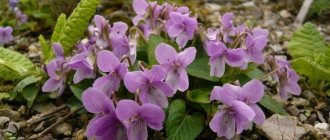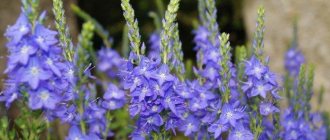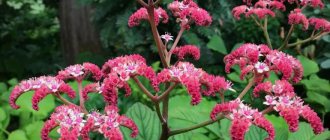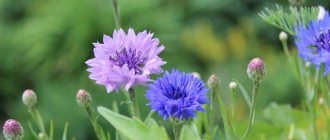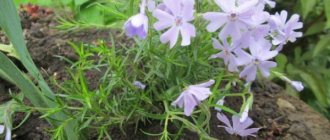general information
Scilla or scilla is a classic bulbous perennial with all the attendant features. Oddly enough, it belongs to the asparagus family, but previously it was classified as a lily plant. Due to the constant confusion in popular nicknames, Scylla is often confused with snowdrops and woodworts.
In nature, blueberries prefer meadows and plains, and are found throughout our continent and even in Africa. Scillas germinate quickly, with the apical inflorescences blooming simultaneously with the growth of long linear leaves. The flowers resemble blue bells and delight with their beauty at the very beginning of spring.
Photo: zvezdagukovo.ru
Description of the flower
Inexperienced gardeners focus on plants that are minimally demanding and adapt well to various conditions. They are much more practical than exotic varieties of crops that require complex care. A good choice is scylla, also known as scilla, sometimes classified as one of the snowdrops. This type is quite decorative and has an excellent immune level. Scylla is a typical perennial.
In nature, it is found in various regions of Europe, Asia and even Africa. Traditionally, this genus was classified as part of the Liliaceae or Hyacinthaceae family, but then botanists changed their point of view.
According to modern classification, it belongs to the Asparagus family, other representatives of which are:
- aloe;
- purchased;
- Pushkinia;
- lily of the valley;
- hyacinth;
- yucca;
- actually asparagus.
Primrose - another name - is quite frost-resistant. The culture looks quite beautiful. These are typical spring perennials. Outwardly they look gentle and elegant. In nature, Scylla inhabits forest and meadow areas, where it forms a lush blue carpet. Scilla is very stable and tenacious. It is characterized by elongated internodes. As they develop, the stems turn into thin rhizomes. The bulbs are distributed along their sides. Flowering in indoor and garden specimens is characteristic of only a few varieties.
Types of woodlands
Dozens of varieties of blueberries are successfully cultivated in gardening. In fact, they are quite similar to each other and are difficult to unequivocally classify, but we tried!
Bell-shaped scilla
It has another completely different name - Spanish endymion. Compact bushes grow up to 30 cm, and long racemose inflorescences form on each peduncle. One such inflorescence includes up to 10 blue, white or pink bells.
Photo: pinterest.ru
Peruvian scilla
Mediterranean species, tall enough for a scilla - up to 35-40 cm in height. The inflorescences here are more conical in shape, and quite dense - several dozen small flowers in each.
Photo: whatflower.ru
Two-leaved scilla
This is a very tiny species, up to 15 cm high and with small peduncles. The pink and white buds are notable for their strong, pungent aroma. Despite its modest size, there are up to 15 bells in one inflorescence.
Photo: fotoload.ru
Siberian scilla
This is a large category, which also includes Caucasian and Armenian blueberries. The flowers bloom simultaneously with the growth of long, elongated leaves. Among the varieties you can find, it seems, all existing shades of blue and purple.
Photo: club.osinka.ru
Autumn Scilla
A rare African and Asian species that blooms not in early spring, but in early autumn. On a small bush up to 20 cm high, 3-5 flower stalks with small lilac or purple buds grow.
Photo: plantarium.ru
Statica (50 photos): types, care and planting in open ground
Application in landscape design
More often the plant is used for decorative purposes. Scylla will decorate alpine slides, paths and flower beds. Thanks to its early flowering, it allows you to create a beautiful picture in landscape design from the first warm days. It is often planted under apple, pear, and cherry trees - creating a beautiful contrast between the purple flowers of the scilla and the snow-white or pink inflorescences of the tree itself.
The flower grows in the southern regions, but in northern conditions it can be planted in greenhouses or winter gardens. Despite its name, it is practically not used in Siberia and the Far East, where its closely related species predominate, more resistant to cold winters and temperature changes, as well as conditions of high humidity.
Caring for blueberries
Scilla are frost-resistant, they have excellent immunity and perfectly adapt to any environmental conditions. And this is another reason for their popularity among gardeners!
Temperature and lighting
Spring species of woodlands especially need good lighting. They are completely unpretentious to our temperatures, but without light they will not grow normally. But some summer and autumn varieties prefer partial shade.
Photo: cvetyphoto.blogspot.com
Watering
Scilla loves high humidity, but does not tolerate floods and stagnant water. You need to water the flowering flower bed very carefully so as not to touch the flowers.
Photo: oir.mobi
The soil
The soil needs to be loose, rich in organic matter, slightly moist, with leaves and bark. Almost like being in a forest! Looseness is the main requirement, because if the soil does not allow water to pass through well, the bulbs will begin to rot.
Photo: flo.discus-club.ru
Fertilizers and fertilizing
In order for the garden scilla to bloom for a really long time, abundantly and evenly, it needs fertilizing. Of course, she can cope without them, like her forest relatives, but the decorative effect suffers significantly. Use liquid mineral fertilizers in the spring, and slowly soluble granules in the fall.
Photo: ogorodniki.com
Wintering
Immediately after flowering, cut off the flower stalks, but leave the leaves. They need to be removed when they die off on their own so that the bulb has time to stock up on nutrients. Scilla can overwinter directly in the ground, unless the open areas should be covered with leaves or spruce branches.
Photo: braggartkurtki.ru
Brunner (50 photos): types, care and planting in open ground
Suitable soil
Siberian bluebell, photos of which are presented in our article, prefers loose soil rich in leaf humus. Dry sandy soil requires deeper planting. If the blueberry is not grown in open ground, then the pot must have drainage at the bottom. Siberian bluegrass does not tolerate acidic soils. Slightly acidic or neutral soil will be optimal. He loves mulching, that is, covering the root zone with various materials such as leaves, bark of deciduous trees, straw, pebbles to preserve moisture and beneficial properties of the soil. The needles and bark of coniferous trees are not suitable as shelter for this plant.
Planting and propagation
Scilla are almost never grown from seeds because they have low germination rates and flowering will begin only after 3-4 years. Therefore, we advise you to immediately plant the bulbs about a month before the expected formation of flower stalks.
First, dig up the soil with organic matter, and ideally also add some forest soil. Bury the bulbs by 6-8 cm and in increments of 5-10 cm, depending on their size. All planting material must first be carefully sorted and treated with fungicides.
Once every 2-3 years, it is recommended to replant the woodlands to preserve their decorative properties. At the same time, you can propagate them by separating the babies from the mother bulbs. The best time for such manipulations is the end of September.
Photo: sadrium.ru
Pest and disease control
Scillas suffer from the typical set of problems of bulbous plants. In particular, these are gray rot, bulb rot and Achellenchoides. Diseased plants must be completely destroyed, and the nearest bulbs around should be kept in hot water and treated with fungicides.
Small garden rodents feed on the bulbs and sprouts of blueberries. Traps, baits and protective ditches are effective against them. Another serious problem is root mite, which hides underground. For treatment and prevention, special insectoacaricides are used.
Photo: pinterest.com
Cosmea (50 photos): types, care and planting in open ground
Scillas – photo
And so that no one ever confuses scillas with other primroses again, we have collected a large photo gallery of them!
Photo: flo.discus-club.ru
Photo: podruga.www.nn.ru
Photo: es.m.wikipedia.org
Photo: sladkiyson.net
Photo: pinterest.ru
Photo: cvetyphoto.blogspot.com
Photo: plantarium.ru
Photo: liveinternet.ru
Photo: culture.ru
Photo: wallbox.ru
Photo: culture.ru
Photo: na-dache.pro
Photo: tvplaneta.ru
Photo: oir.mobi
Photo: zen.yandex.ru
Photo: zen.yandex.ru
Photo: planetalsad.com
Photo: cveti-rasteniya.ru
Photo: tsvety-bukety.ru
Photo: stridvall.se
Photo: mirnadivane.ru
Photo: pinterest.ru
Photo: wallbox.ru
Photo: cvetyphoto.blogspot.com
Photo: commons.m.wikimedia.org
Did you like the post? Subscribe to our channel in Yandex.Zen, it really helps us in our development!
